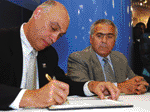Harris, Lockheed sign partnering agreement

<FONT SIZE=2>For Harris Corp. and Lockheed Martin Corp., the plan to join forces in air traffic management was a long time in coming.</FONT>

Bob Henry, president of Harris Corp.'s Government Communications Systems division, and Don Antonucci, president of Lockheed Martin Air Traffic Management, sign the agreement Nov.6 establishing a strategic alliance between the companies.
Henrik G. deGyor
"Two years ago, we started a conversation about this [alliance] and something always got in the way," said Bob Henry, president of Harris' Government Communications Systems division. This time the discussions went quickly, a little over two months, with the last step being the approval by lawyers on both sides.
The two companies, already dominant in the global air traffic management industry, announced Nov. 6 they will pursue opportunities together in the estimated $5 billion global market for airspace management solutions.
"For years we've been hearing about harmonizing solutions," said Don Antonucci, president of Lockheed Martin Air Traffic Management. "We're sending a message that finding ... the benefits on behalf of our customers [truly] can be accomplished."
Under the terms of the agreement, Lockheed Martin of Bethesda, Md., and Harris of Melbourne, Fla., will assess opportunities as they come along to determine which company will bid as prime contractor. Lockheed Martin will lead opportunities related to air traffic management automation, navigation and traffic flow management, while Harris will take the lead in projects involving communications and weather.
Antonucci said the companies will meet once a quarter to review plans and discuss opportunities.
Lockheed Martin and Harris have competed against each other and collaborated together on numerous air traffic management contracts over the years. For instance, they competed head-to-head for the Federal Aviation Administration's Telecommunications Infrastructure contract, a program worth up to $3.5 billion over 15 years to upgrade the agency's communications infrastructure. In July, the award went to Harris, which also beat WorldCom Inc., the contract incumbent. Lockheed Martin has joined Harris' team as a subcontractor.
Lockheed was chosen in August as the prime contractor, with Harris as subcontractor, for the FAA's En Route Automation Modernization project, to modernize computer hardware and software at 20 en route centers around the country. And another Lockheed division, Lockheed Martin Mission Systems, is one of two prime contractors working on the early phases of the Army's Warfighter Information Network-Tactical, a $6.6 billion project to provide the communications network for the service's Objective Force. Harris is also subcontracting to Lockheed Martin on WIN-T.
The two companies also are teaming to pursue the FAA's 10-year, $500 million Next Generation Air/Ground Communications program, called Nexcom, with Harris taking the lead role. There are opportunities in other countries, the two companies said, but they declined to specify them.
"This provides some structure in how we interact with each other," said Ron Morgan, vice president of strategic planning for Lockheed Martin ATM. "Prior to this agreement, I would characterize [our partnerships] as opportunistic."
There are several benefits to Harris in this formal teaming agreement, Henry said. The company can direct its internal research and development toward those areas where it will pursue a prime contracting role, he said, while Lockheed Martin can do the same.
The agreement will make it easier for the two companies to work together, respond to new opportunities faster and integrate systems more quickly. On international projects, Lockheed Martin -- with annual revenue of $24 billion in fiscal 2001, compared to Harris' $1.9 billion -- has the deep pockets to last through what frequently are yearslong selection processes requiring millions of dollars of upfront investment.
On the other hand, Lockheed Martin's air traffic management unit employs more than 1,200 people globally, while Harris' business unit represents half of the company's income and employs about half of the company's 9,700 employees, company spokesmen said.
The agreement does not mean the two companies must collaborate on projects, representatives from both companies said. Henry said it is more as a "right of first refusal" when putting a team together.
While the two companies touted the pact as a major step, some industry observers dismissed the importance of the joint agreement.
"Whether they have a subcontract arrangement or teaming arrangement, the end result is the same," said Paul Nisbet, principal, JSA Research, Newport, R.I. "I don't know where this is likely to lead; I would guess we won't see a lot of evidence of change. Certainly, from the point of view that we take, looking at the earnings of the company and the stock price, I don't see anything there that signals I'm going to have to make a change."
Competitors are similarly sanguine.
Said Blanche Necessary, a spokeswoman for Raytheon Co., Lexington, Mass.: "We continue to work with both companies on various ATM programs. We are teamed with Lockheed and Harris on Nexcom and Lockheed on STARS and ERAM."
Chicago-based Boeing Co. last year created an air traffic management division to pursue opportunities in this market. The company has met with some early success, most recently winning a contract for a pilot program to assess the feasibility of satellite-based air traffic management systems.
"I'm not really surprised by announcements like that, because there are all sorts of partnerships announced all the time in the aerospace industry," said Boeing spokesman Tim Neale. "The nature of many of the projects are very large and really require companies to team with one another." *
Staff Writer Patience Wait can be reached at pwait@postnewsweektech.com.